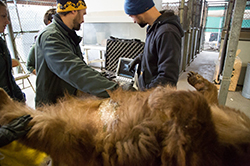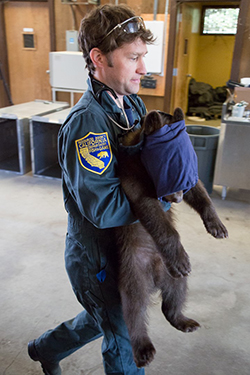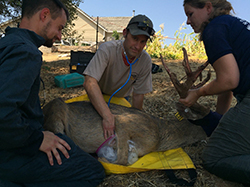
Brandon Munk performs an ultrasound exam on a black bear to determine pregnancy. CDFW photo: Travis VanZant.

Brandon Munk moves an anesthetized bear club to an exam table. CDFW photo Travis VanZant.

Brandon Munk tends to a deer which was tranquilized and treated after its antlers became snagged in a plastic fence. CDFW photo: Steve Torres.
CDFW Veterinarian Brandon Munk joined CDFW’s Wildlife Investigations Laboratory as the veterinary lead for the deer, bear and restricted species programs just over two years ago. Currently, he is acting as the veterinary lead for all big game species. The Wildlife Investigations Laboratory was established in 1941 to conduct wildlife disease investigations. Over the years, its responsibilities have increased to include: the statewide investigation of wildlife mortality events; wildlife disease surveillance and research; wildlife health monitoring and research; prevention of wildlife diseases; wildlife project and capture support; wildlife rehabilitation; injured and nuisance wildlife; wildlife handling and safety training; the statewide pesticides in wildlife program; wildlife conflict and human dimensions programs; wolf and lion species programs; biometrics; and wildlife conservation genetics.
Brandon completed a Master’s of Science in behavioral ecology at the University of Wyoming prior to pursing his Doctor of Veterinary Medicine (DVM) at Colorado State University. After receiving his DVM, Brandon began his career as a wildlife veterinarian by spending three years as a Post-Doctoral Research Associate at the University of Georgia’s Southeastern Cooperative Wildlife Disease Study (SCWDS) working as a wildlife diagnostician, wildlife disease specialist, and chronic wasting disease coordinator. While at SCWDS Brandon honed his skills and expertise in pathology, diagnostics and wildlife diseases by providing support to state and federal wildlife agencies. Brandon also spent time as a small animal and exotic animal clinician before finally landing a wildlife veterinarian’s dream job at CDFW.
What prompted your choosing a career as a veterinarian?
I have always held a keen interest in medicine and have always been passionate about animals, particularly wildlife, and the outdoors. However, I had always thought academia was the only path for someone with such interests. It was not until I was well into my 20s that I met some fairly non-traditional science professionals and began exploring a career in veterinary medicine. I spent time volunteering at veterinary clinics and fell in love with the diversity of veterinary medicine. I pursued my Masters while exploring vet schools and consider myself very fortunate to have been able to participate in and complete both programs, gaining very different experiences and training from each.
You joined CDFW fairly recently. What attracted you to the department?
The field of wildlife medicine is still fairly new and quite small, with few opportunities to mentor under or collaborate directly with other wildlife veterinarians. The department provided a very unique opportunity to do both with three wildlife veterinarians at the WIL, a fourth with the Office of Spill Prevention and Response, and others working for Fisheries. There are exceedingly few wildlife agencies with this number and diversity of veterinarians. This was truly a unique opportunity!
What is a typical day like for you at work?
Hard to predict. While at the office I may be: performing necropsies (animal autopsies) as part of a mortality investigation; immobilizing injured or conflict bears for exams or transfer; training department staff on wildlife disease investigations, wildlife restraint or chemical immobilizations; fielding phone calls from biologists about sick, injured, conflict or research animals; working with biologists to initiate and support wildlife capture activities; coordinating statewide wildlife disease surveillance activities; coordinating with other state or federal animal or public health agencies on disease of mutual concern; and the list goes on. My days spent in the field, somewhat surprisingly, tend to be a little more predictable. On game captures I am responsible for the safety and welfare of the animals captured, whether it’s treating wounds, providing prophylactic treatments, ensuring animals are as comfortable as possible while being handled, or training new staff in some of these key animal welfare duties.
What is the most rewarding project that you have worked on thus far at CDFW?
The Sierra Nevada bighorn sheep recovery project. The species has such a storied history and a very dedicated conservation following. I have been the primary veterinarian on that project for the last year, involved with captures and disease surveillance. The people involved with the recovery project, both department staff and volunteers, are amazing and intensely dedicated to the effort.
What aspect of working in the Wildlife Investigations Lab is unique?
The diversity in expertise, from veterinarians to geneticists, ecologists, disease biologists and toxicologists. There is a ton of expertise here, it’s quite amazing!
What is your favorite species to interact with or study?
I like them all, but interact most frequently with deer and bear. I like deer because they may be the most important herbivores on the landscape and as such fill an important ecological role. From a wildlife health perspective, we know more about deer then many of the other species we work with, which means I have a broader knowledge base to work from. Bighorn sheep are an equally interesting species from a wildlife health perspective because there are a few well-documented and important disease issues to consider. Sheep are also one of the more forgiving species to actually handle – they tend to be more calm and tractable while in hand, relative to our other game species at least. Bear are interesting from a wildlife health perspective because there is very little known about the diseases affecting them. Plus, bears are just pretty darn cool critters in general. Elk are a majestic species and in many ways similar to deer but with some very different peculiarities. Antelope offer some very unique challenges, as they tend to be difficult to capture and to work with safely, but are amazingly adapted animals. Pigs are extremely adaptive animals that can act as reservoir hosts for various diseases of wildlife, livestock and public health concerns, and as such offer some unique challenges. However, if the question is what are my favorite animals to actually have in hand and work with, I would have to say deer.
Which species is the most difficult to work on and why?
In the broadest sense, I’d have to say that some of our sheep species are the most difficult to work on. Not so much because of difficulties while in hand, but more so because of their remoteness and the logistics of their capture. It takes massive group efforts to safely and successfully capture bighorn sheep.
If you had free reign and unlimited funding, what scientific project would you most like to do?
Determining the ecological health significance, if any, of micronutrient deficiencies, specifically selenium and copper, in deer and other free-ranging ungulates. Selenium and copper deficiencies are fairly common findings in deer throughout California. Indeed, selenium and copper deficiencies are also important diseases in domestic ungulates throughout much of California. Both selenium and copper are important for normal immune function and deficient animals may be more susceptible to infectious diseases or other conditions. Empirical evidence suggests that low selenium may decrease fecundity (fertility) and fawn recruitment, at least at the individual animal level. I’d like to study whether there are measurable population health effects, and if so, what management practices might increase the bioavailability of copper and selenium for these species.
Any advice for people considering careers in science or natural resources?
Love what you do, because it is rarely easy.
CDFW Photos. Top Photo: Brandon Munk completes a physical exam on an anesthetized bear cub. The black bear was captured by CDFW wildlife officers due to human-wildlife conflict and was later placed at the Oakland Zoo.